
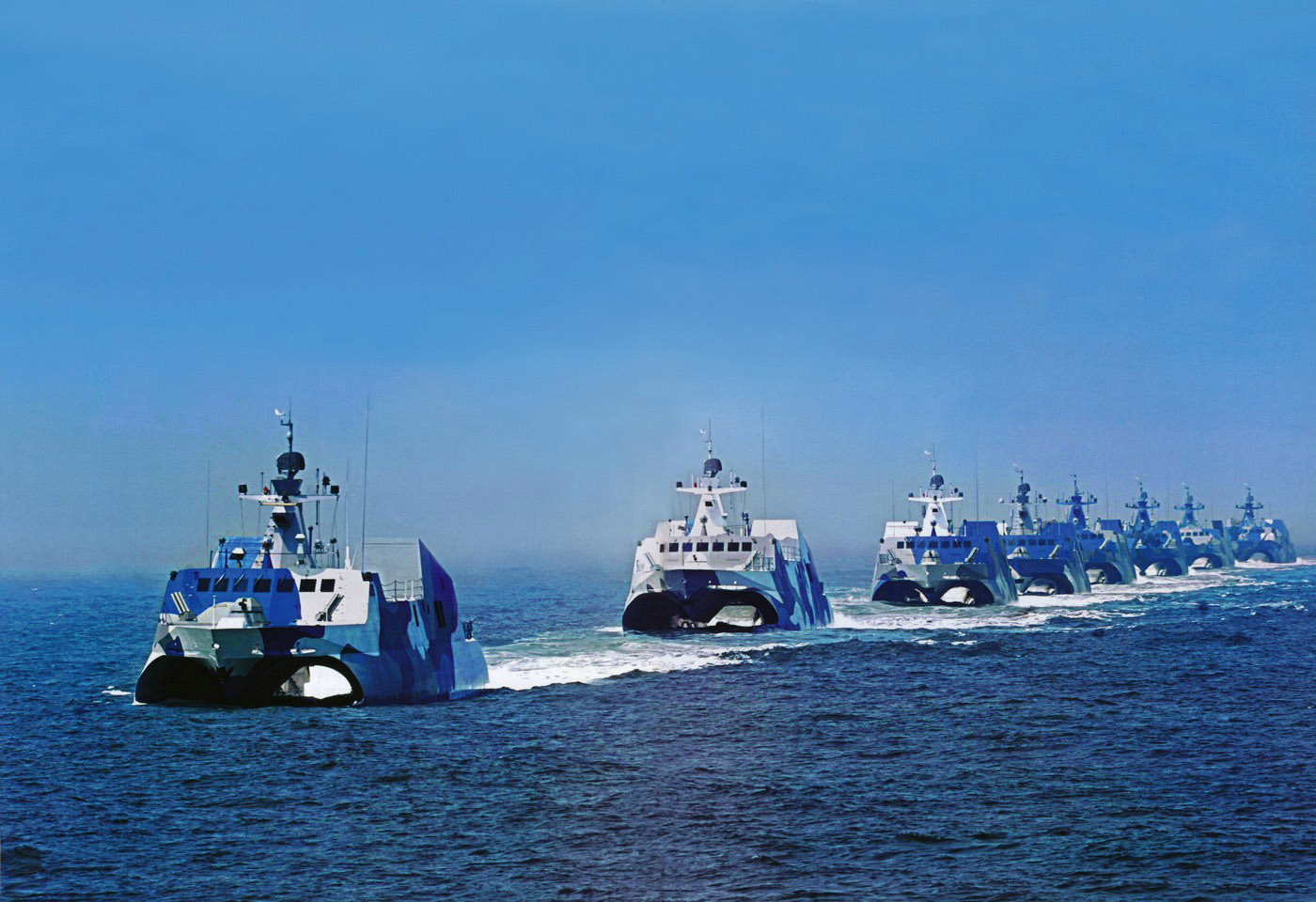
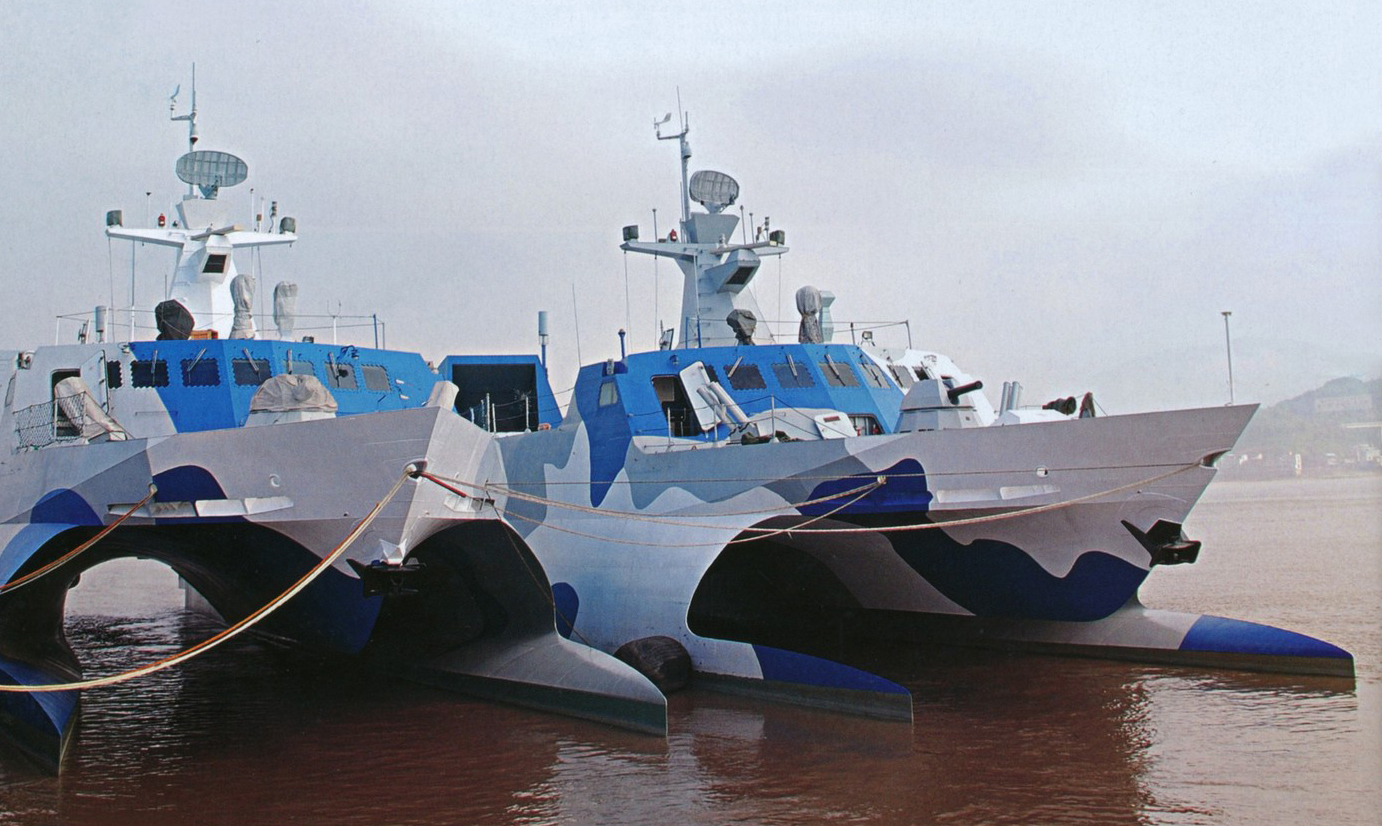


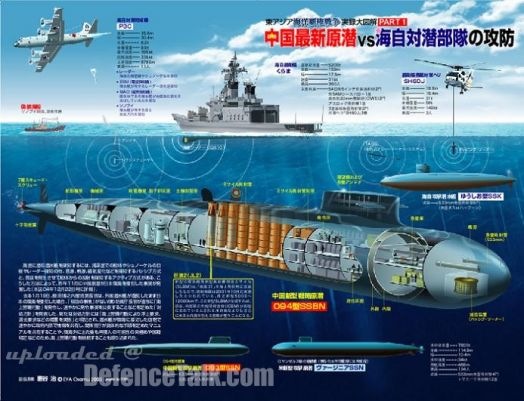





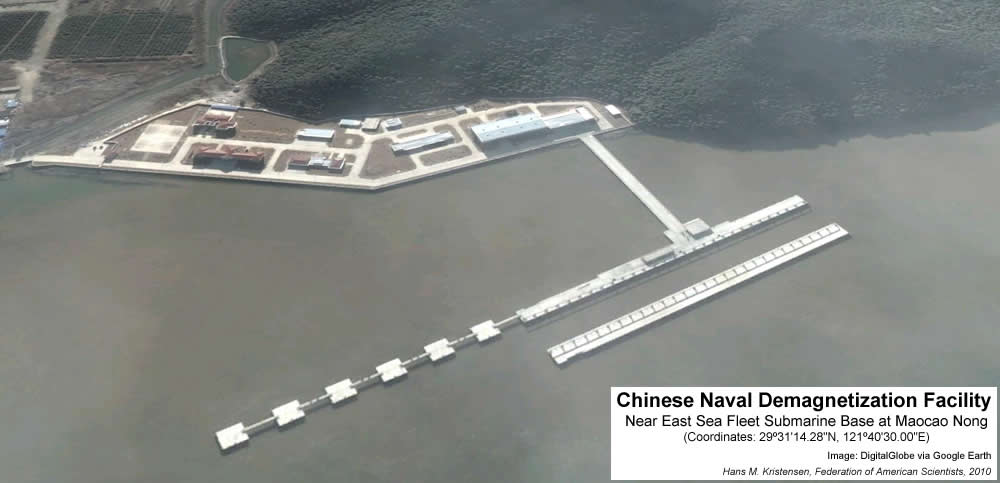

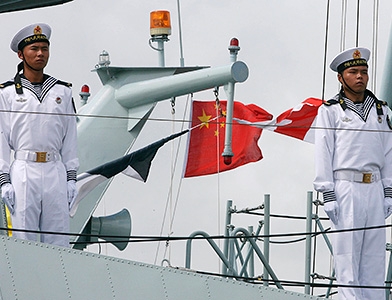




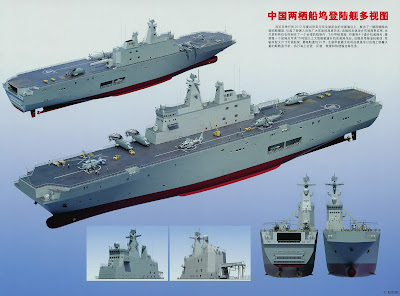

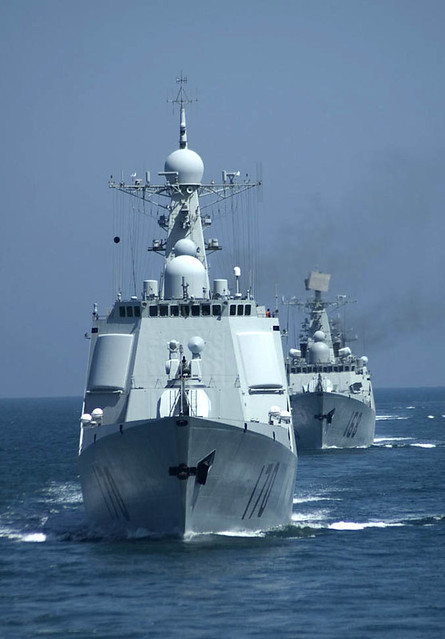






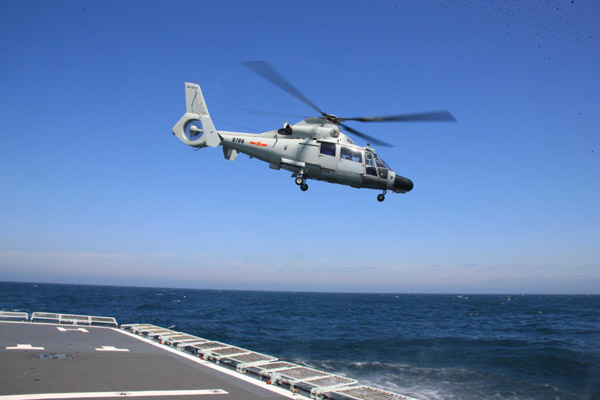

People's Liberation Army Navy
From Wikipedia, the free encyclopedia
"Chinese Navy" redirects here. For other naval forces sharing a similar name, see Chinese Navy (disambiguation).
| People's Liberation Army Navy 中国人民解放军海军 |
|
|---|---|

Flag of the People's Liberation Army Navy
|
|
| Active | September 1950–present |
| Country | |
| Branch | People's Liberation Army |
| Type | Navy |
| Role | Naval warfare |
| Size | 255,000 personnel (2012)[1] 469 ships 650 aircraft[2][3] |
| Engagements | Chinese Civil War Battle of the Paracel Islands Sino-Vietnamese War Anti-piracy operations in Somalia |
| Commanders | |
| Current commander |
Admiral Wu Shengli, PLA-N |
| Aircraft flown | |
| Attack | JH-7 |
| Bomber | H-6, Q-5 |
| Electronic warfare |
Y-8 |
| Fighter | J-8, J-10, J-11, Su-30MK2 |
| Helicopter | Z-8, Z-9, Mi-8, Ka-28, AS365 |
| Interceptor | J-7 |
| Patrol | Y-8 |
| Trainer | JL-8, JL-9 |
| Transport | Y-7 |
| People's Liberation Army Navy | |||
| Traditional Chinese | 中國人民解放軍海軍 | ||
|---|---|---|---|
| Simplified Chinese | 中国人民解放军海军 | ||
|
|||
The People's Liberation Army Navy (PLAN or PLA Navy) is the naval warfare branch of the People's Liberation Army, the national armed forces of the People's Republic of China. The PLAN can trace its lineage to naval units fighting during the Chinese Civil War and was established in September 1950. Throughout the 1950s and early 1960s the Soviet Union provided assistance to the PLAN in the form of naval advisers and export of equipment and technology.[4] Until the late 1980s, the PLAN was largely a riverine and littoral force (brown-water navy). However by the 1990s, following the fall of the Soviet Union and a shift towards a more forward-oriented foreign and security policy, the leaders of the Chinese military were freed from worrying over land border disputes, and instead turned their attention towards the seas. This led to the development of the People's Liberation Army Navy into the green-water navy it is today.[5] Before the 1990s the PLAN had traditionally played a subordinate role to the People's Liberation Army Ground Force.
In 2008, General Qian Lihua confirmed that China plans to operate a small fleet of aircraft carriers in the near future, but for the purpose of regional defence as opposed to "global reach".[6] As of 2013 PLA officials have also outlined plans to operate in the first and second island chains.[7] Chinese strategists term the development of the PLAN from a green-water navy into "a regional blue-water defensive and offensive navy."[8]
The People's Liberation Army Navy is composed of five branches; the People's Liberation Army Navy Submarine Force, the People's Liberation Army Navy Surface Force, the People's Liberation Army Navy Coastal Defense Force, the People's Liberation Army Marine Corps and the People's Liberation Army Naval Air Force.[9] With a personnel strength of 255,000[1][10] servicemen and women, including 10,000 marines and 26,000 naval air force personnel, it is the second largest navy in the world, behind only the United States Navy. PLAN assets include 1 aircraft carrier, 3 amphibious transport docks, 26 landing ship tanks, 67 submarines (of which 14 are nuclear-powered), 25 destroyers, 42 frigates, 14 corvettes, 105 missile boats, 131 gunboats, 67 mine countermeasures vessels, 7 replenishment oilers and a fleet of various auxiliary vessels.[5][11][12]
Contents
History
See also: Naval history of China
The PLAN traces its lineage to units of the Republic of China Navy who defected to the People's Liberation Army towards the end of the Chinese Civil War. In 1949, Mao Zedong asserted that "to oppose imperialist aggression, we must build a powerful navy". During the Landing Operation on Hainan Island, the communists used wooden junks fitted with mountain guns as both transport and warships against the Republic of China Navy. The Naval Academy was set up at Dalian
on 22 November 1949, mostly with Soviet instructors. The navy was
established in September 1950 by consolidating regional naval forces
under General Staff Department command in Jiangyan, now in Taizhou, Jiangsu province. It then consisted of a motley collection of ships and boats acquired from the Kuomintang forces. The Naval Air Force
was added two years later. By 1954 an estimated 2,500 Soviet naval
advisers were in China—possibly one adviser to every thirty Chinese
naval personnel—and the Soviet Union began providing modern ships. With Soviet assistance, the navy reorganized in 1954 and 1955 into the North Sea Fleet, East Sea Fleet, and South Sea Fleet, and a corps of admirals and other naval officers was established from the ranks of the ground forces. In shipbuilding
the Soviets first assisted the Chinese, then the Chinese copied Soviet
designs without assistance, and finally the Chinese produced vessels of
their own design. Eventually Soviet assistance progressed to the point
that a joint Sino-Soviet Pacific Ocean fleet was under discussion.1950s and 1960s
Through the upheavals of the late 1950s and 1960s the Navy remained relatively undisturbed. Under the leadership of Minister of National Defense Lin Biao, large investments were made in naval construction during the frugal years immediately after the Great Leap Forward. During the Cultural Revolution, a number of top naval commissars and commanders were purged, and naval forces were used to suppress a revolt in Wuhan in July 1967, but the service largely avoided the turmoil affecting the country. Although it paid lip service to Mao and assigned political commissars aboard ships, the Navy continued to train, build, and maintain the fleets as well the coastal defense and aviation arms, as well as in the performance of its mission.1970s and 1980s
In the 1970s, when approximately 20 percent of the defense budget was allocated to naval forces, the Navy grew dramatically. The conventional submarine force increased from 35 to 100 boats, the number of missile-carrying ships grew from 20 to 200, and the production of larger surface ships, including support ships for oceangoing operations, increased. The Navy also began development of nuclear-powered attack submarines (SSN) and nuclear-powered ballistic missile submarines (SSBN).In 1986 the Navy's order of battle included two Xia-class SSBNs armed with twelve CSS-N-3 missiles and three Han-class SSNs armed with six SY-2 cruise missiles. In the late 1980s, major deficiencies reportedly remained in antisubmarine warfare, mine warfare, naval electronics (including electronic countermeasures equipment), and naval aviation capabilities.
The PLA Navy was ranked in 1987 as the third largest navy in the world, although naval personnel had comprised only 12 percent of PLA strength. In 1987 the Navy consisted (as it does now) of the naval headquarters in Beijing; three fleet commands – the North Sea Fleet, based at Qingdao, Shandong; the East Sea Fleet, based at Ningbo; and the South Sea Fleet, based at Zhanjiang, Guangdong – and about 2,000 ships. The 350,000-person Navy included Naval Air Force units of 34,000 men, the Coastal Defense Forces of 38,000, and the Marine Corps of 56,500. Navy Headquarters, which controlled the three fleet commands, was subordinate to the PLA General Staff Department. In 1987, China's 1,500 km coastline was protected by more than 100 diesel-powered Romeo- and Whiskey-class submarines, which could remain at sea only a limited time. Inside this protective ring and within range of shore-based aircraft were destroyers and frigates mounting Styx anti-ship missiles, depth-charge projectors, and guns up to 130 mm. Any invader penetrating the destroyer and frigate protection would have been swarmed by almost 900 fast-attack craft. Stormy weather limited the range of these small boats, however, and curtailed air support. Behind the inner ring were Coastal Defense Force personnel operating naval shore batteries of Styx missiles and guns, backed by ground force units deployed in depth.
Into the 21st century
As the 21st century approached, the PLAN began to transition to an off-shore defensive strategy that entailed more out-of-area operations away from its traditional territorial waters.[14] Between 1989 and 1993, the training ship Zhenghe paid ports visits to Hawaii, Thailand, Bangladesh, Pakistan, and India. PLAN vessels visited Vladivostok in 1993, 1994, 1995, and 1996. PLAN task groups also paid visits to Indonesia in 1995; North Korea in 1997; New Zealand, Australia, and the Philippines in 1998; Malaysia, Tanzania, South Africa, the United States, and Canada in 2000; and India, Pakistan, France, Italy, Germany, Britain, Hong Kong, Australia, and New Zealand in 2001.[15] In March 1997, the Luhu-class guided missile destroyer Harbin, the Luda-class guided missile destroyer Zhuhai, and the replenishment oiler Nancang began the PLA Navy's first circumnavigation of the Pacific Ocean, a 98-day voyage with port visits to Mexico, Peru, Chile, and the United States, including Pearl Harbor and San Diego. The flotilla was under the command of Vice Admiral Wang Yongguo, the commander-in-chief of the South Sea Fleet.[15][16][17][18][19][20]The Luhu-class guided missile destroyer Qingdao and the replenishment oiler Taicang completed the PLA Navy's first circumnavigation of the world (pictured), a 123-day voyage covering 32,000 nautical miles (59,000 km; 37,000 mi) between 15 May – 23 September 2002. Port visits included Changi, Singapore; Alexandria, Egypt; Aksis, Turkey; Sevastopol, Ukraine; Piraeus, Greece; Lisbon, Portugal; Fortaleza, Brazil; Guayaquil, Ecuador; Callao, Peru; and Papeete in French Polynesia. The PLA naval vessels participated in naval exercises with the French frigates Nivôse and Prairial, as well as exercises with the Peruvian Navy. The flotilla was under the command of Vice Admiral Ding Yiping, the commander-in-chief of the North Sea Fleet, and Captain Li Yujie was the commanding officer of the Qingdao.[21][22][23][24][25][26][27] Overall, between 1985 and 2006, PLAN naval vessels visited 18 Asian-Pacific nations, 4 South American nations, 8 European nations, 3 African nations, and 3 North American nations.[28] In 2003, the PLAN conducted its first joint naval exercises during separate visits to Pakistan and India. Bi-lateral naval exercises were also carried out with exercises with the French, British, Australian, Canadian, Philippine, and United States navies.[29]
On 26 December 2008, the PLAN dispatched a task group consisting of the guided missile destroyer Haikou (flagship), the guided missile destroyer Wuhan, and the supply ship Weishanhu to the Gulf of Aden to participate in anti-piracy operations off the coast of Somalia. A team of 16 Chinese Special Forces members from its Marine Corps armed with attack helicopters were on board.[30][31][32] Since then, China has maintained a three-ship flotilla of two warships and one supply ship in the Gulf of Aden by assigning ships to the Gulf of Aden on a three monthly basis. Other recent PLAN incidents include the 2001 Hainan Island incident, a major submarine accident in 2003, and naval incidents involving the U.S. MSC-operated ocean surveillance ships Victorious and Impeccable during 2009. At the occasion of the 60th anniversary of the PLAN, 52 vessels were shown in manoeuvres off Qingdao in April 2009 including previously unseen nuclear submarines. The demonstration was seen as a sign of the growing status of China, while the CMC Chairman, Hu Jintao, indicated that China is neither seeking regional hegemony nor entering an arms race.[33] Predictions by Western analysts that the PLAN would outnumber the USN submarine force as early as 2011 have failed to come true because the PRC curtailed both imports and domestic production of submarines.[34]
Between 5–12 July 2013, a seven-ship task force from the Northern Fleet joined warships from the Russian Pacific Fleet to participate in Joint Sea 2013, bilateral naval maneuvers held in the Peter the Great Bay of the Sea of Japan. To date, Joint Sea 2013 was the largest naval drills yet undertaken by the People's Liberation Army Navy with a foreign navy.[35]
PRC military expert Yin Zhuo has said that due to present weaknesses in the PLAN's ability to replenish their ships at sea, their future aircraft carriers will be forced to operate in pairs.[36]
Organization
Main article: People's Liberation Army Navy Organization
Fleets
The People's Liberation Army Navy is divided into three fleets:[37]- The North Sea Fleet, based in the Yellow Sea and headquartered in Qingdao, Shandong Province.
- The East Sea Fleet, based in the East China Sea and headquartered in Ningbo, Zhejiang Province.
- The South Sea Fleet, based in the South China Sea and headquartered in Zhanjiang, Guangdong Province.
Branches
PLAN Submarine Force
Main article: People's Liberation Army Navy Submarine Force
The People's Liberation Army Navy Submarine Force is one of five
branches in the navy and consists of all submarines both nuclear-powered
and conventionally-powered in service with the PLAN. They are organised
into flotillas spread across the three main fleets.[38]The PRC plans to be the last of the permanent members of the United Nations Security Council to conduct an operational ballistic missile submarine patrol.[39]
PLAN Surface Force
Main article: People's Liberation Army Navy Surface Force
The People's Liberation Army Surface Force is one of five branches in
the navy and consists of all surface warfare ships in service with the
PLAN. They are organised into flotillas spread across the three main
fleets.[40]PLAN Coastal Defence Force
Main article: People's Liberation Army Navy Coastal Defense Force
The PLAN Coastal Defence Force is a land-based fighting force and branch of the PLAN[41]
with a strength of around 25,000 personnel. Also known as the coastal
defense troops, they serve to defend China's coastal areas from invasion
via amphibious landings or air-attack. Throughout the 1960s to 1980s,
the Coastal Defense Force was focused on defending China's coast from a
possible Soviet sea-borne invasion. With the fall of the Soviet Union,
the threat of an amphibious invasion of China has diminished and
therefore the branch is often considered to no-longer to be a vital
component of the PLAN. Especially as the surface warships of the PLAN
continue to improve in terms of anti-ship and air-defence capabilities.Today the primary weapons of the coastal defense troops are the HY-2, YJ-82, and C-602 anti-ship missiles.
PLA Marine Corps
Main article: People's Liberation Army Marine Corps
With the PLAN's accelerating efforts to expand its capabilities beyond territorial waters, it would be likely for the Marine Corps to play a greater role in terms of being an offshore expeditionary force similar to the USMC and Royal Marines.
Main article: People's Liberation Army Naval Air Force
The People's Liberation Army Naval Air Force is the "air force" of
the PLAN and has a strength of around 25,000 personnel and 430 aircraft.
It operates similar aircraft to the People's Liberation Army Air Force,
including fighter aircraft, bombers, strike aircraft, tankers,
reconnaissance aircraft, electronic warfare aircraft, maritime patrol
aircraft, transport aircraft, and helicopters of various roles. The PLA
Naval Air Force has traditionally received older aircraft than the PLAAF
and has taken less ambitious steps towards mass modernization.
Advancements in new technologies, weaponry and aircraft acquisition were
made after 2000. With the introduction of China's first aircraft
carrier, Liaoning the Naval Air Force is for the first time conducting aircraft carrier operations.[42] Naval Air Bases includes:- North Sea Fleet: Dalian, Qingdao, Jinxi, Jiyuan, Laiyang, Jiaoxian, Xingtai, Laishan, Anyang, Changzhi, Liangxiang and Shan Hai Guan
- East Sea Fleet: Danyang, Daishan, Shanghai (Dachang), Ningbo, Luqiao, Feidong and Shitangqiao
- South Sea Fleet: Foluo, Haikou, Lingshui, Sanya, Guiping, Jialaishi and Lingling
Relationship with other maritime organisations of China
See also: China Coast Guard
The PLAN is complemented by paramilitary
maritime services such as the China Coast Guard. The Chinese Coast
Guard was previously not under an independent command, considered part
of the armed police, under the local (provincial) border defense force
command, prior to its reorganization and consolidation as an unified
service. It was formed from the integration of several formerly separate
services (such as China Marine Surveillance
(CMS), Hai Guang, People's Armed Police and sea militia). The CMS
performed mostly coastal and ocean search and rescue or patrols. The CMS
received quite a few large patrol ships that significantly enhanced
their operations, while Hai Guang, militia, police and other services
operated hundreds of small patrol craft. For maritime patrol services,
these craft are usually quite well armed with machine guns and 37mm
antiaircraft guns. In addition, these services operated their own small
aviation units to assist their maritime patrol capabilities, with Hai
Guang and CMS operating a handful of Harbin Z-9 helicopters, and a
maritime patrol aircraft based on the Harbin Y-12 STOL transport.Every coastal province has 1 to 3 Coast Guard squadrons:
- 3 Squadrons: Fujian, Guangdong
- 2 Squadrons: Liaoning, Shandong, Zhejiang, Hainan, Guangxi
- 1 Squadron: Heibei, Tianjin, Jiangsu, Shanghai
Ranks
Main article: Ranks of the People's Liberation Army Navy
The ranks in the People's Liberation Army Navy are similar to those of the People's Liberation Army Ground Force.
The current system of officer ranks and insignia dates from 1988 and is
a revision of the ranks and insignia used from 1955 to 1965. The rank
of Hai Jun Yi Ji Shang Jiang (First Class Admiral) was never held and
was abolished in 1994. With the official introduction of the Type 07 uniforms all officer insignia are on either shoulders or sleeves depending on the type of uniform used. The current system of enlisted ranks and insignia dates from 1998.Today
Strategy, plans, priorities
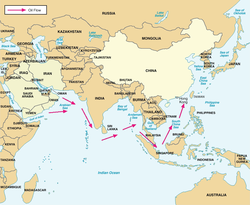
China’s Critical Sea Lines of Communication. In 2004, over 80 percent of Chinese crude oil imports transited the Straits of Malacca, with less than 2 percent transiting the Straits of Lombok.
During a 2008 interview with the BBC, Major General Qian Lihua, a senior Chinese defense official, stated that the PLAN aspired to possess a small number of aircraft carriers to allow it to expand China's air defense perimeter.[47] According to Qian the important issue was not whether China had an aircraft carrier, but what it did with it.[47] On 13 January 2009, Adm. Robert F. Willard, head of the U.S. Pacific Command, called the PLAN's modernization "aggressive," and that it raised concerns in the region.[48] On 15 July 2009, Senator Jim Webb of the Senate Foreign Relations Committee declared that only the "United States has both the stature and the national power to confront the obvious imbalance of power that China brings" to situations such as the claims to the Spratly and Paracel islands.[49]
Ronald O'Rourke of the Congressional Research Service wrote that the PLAN "continues to exhibit limitations or weaknesses in several areas, including capabilities for sustained operations by larger formations in distant waters, joint operations with other parts of China’s military, C4ISR systems, anti-air warfare (AAW), antisubmarine warfare (ASW), MCM, and a dependence on foreign suppliers for certain key ship components."[50] In 1998 China purchased the discarded Ukrainian ship Varyag and began retrofitting it for naval deployment. On 25 September 2012, the People's Liberation Army Navy took delivery of China's first aircraft carrier, the Liaoning.[51] The 60,000 ton ship can accommodate 33 fixed wing aircraft. It is widely speculated that these aircraft will be the J15 fighter (the Chinese version of Russia's SU-33).[52]
Japan has raised concerns about the PLAN's growing capability and the lack of transparency as its naval strength keeps on expanding.[53] China has reportedly[by whom?] entered into service the world's first anti-ship ballistic missile called DF-21D. The potential threat from the DF-21D against U.S. aircraft carriers has reportedly caused major changes in U.S. strategy.[citation needed]
Territorial disputes
See also: Territorial disputes in the South China Sea, East China Sea EEZ disputes and Battle of the Paracel Islands
Spratly Islands dispute
The Spratly Islands dispute is a territorial dispute over the ownership of the Spratly Islands, a group of islands located in the South China Sea. States staking claims to various islands are Brunei, Malaysia, the Philippines, Taiwan, Vietnam, and People's Republic of China. All except Brunei occupy some of the islands in dispute. The People's Republic of China conducted naval patrols in the Spratly Islands and established a permanent base.On 14 March 1988, Chinese and Vietnamese naval forces clashed over Johnson South Reef in the Spratly Islands, which involved three PLAN frigates/[54]
In February 2011, the Chinese frigate Dongguan fired three shots at Philippine fishing boats in the vicinity of Jackson atoll. The shots were fired after the frigate instructed the fishing boats to leave, and one of those boats experienced trouble removing its anchor.[55][56] In May 2011, the Chinese patrol boats attacked and cut the cable of Vietnamese oil exploration ships near Spratly islands. The incidence sparked several anti-China protests in Vietnam. In June, the Chinese navy conducted three days of exercises, including live fire drills, in the disputed waters. This was widely seen as a warning to Vietnam, which had also conducted live fire drills near the Spratly Islands. Chinese patrol boats fired repeated rounds at a target on an apparently uninhabited island, as twin fighter jets streaked in tandem overhead. 14 vessels participated in the maneuvers, staging antisubmarine and beach landing drills aimed at "defending atolls and protecting sea lanes."[57]
In May 2013, the Chinese navy's three operational fleets deployed together for the first time since 2010. This combined naval maneuvers in the South China Sea coincided with the ongoing Spratly Islands dispute between China and the Philippines as well as deployment of the U.S. Navy's Carrier Strike Group Eleven to the U.S. Seventh Fleet.
Diaoyu (Senkaku) Islands dispute
The Diaoyu Islands dispute concerns a territorial dispute over a group of uninhabited islands known as the Diaoyu Islands in China, the Senkaku in Japan,[58] and Tiaoyutai Islands in Taiwan.[59] Aside from a 1945 to 1972 period of administration by the United States, the archipelago has been controlled by Japan since 1895.[60] The People's Republic of China disputed the proposed U.S. handover of authority to Japan in 1971.[61] and has asserted its claims to the islands since that time.[62] Taiwan also has claimed these islands. The disputed territory is close to key shipping lanes and rich fishing grounds, and it may have major oil reserves in the area.[63]On some occasions, ships and planes from various Mainland Chinese and Taiwanese government and military agencies have entered the disputed area. In addition to the cases where they escorted fishing and activist vessels, there have been other incursions. In an eight month period in 2012, over forty maritime incursions and 160 aerial incursions occurred.[64] For example, in July 2012, three Chinese patrol vessels entered the disputed waters around the islands.[65]
Military escalation continued in 2013. In February, Japanese Defense Minister Itsunori Onodera claimed that a Chinese frigate had locked weapons-targeting radar onto a Japanese destroyer and helicopter on two occasions in January.[66][67] A Chinese Jiangwei II class frigate and a Japanese destroyer were three kilometers apart, and the crew of the latter vessel went to battle stations.[68] The Chinese state media responded that their frigates had been engaged in routine training at the time.[69] In late February 2013, U.S. intelligence detected China moving road-mobile ballistic missiles closer to the coast near the disputed islands, including medium-range DF-16 anti-ship ballistic missiles.[70] In May, a flotilla of Chinese warships from its North Sea Fleet deployed from Qingdao for training exercises western North Pacific Ocean.[71] It is not known if this deployment is related to the ongoing islands dispute between China and Japan.
Other incidents
On 11 July 2012, the Chinese frigate Dongguan ran aground on Hasa Hasa Shoal (pictured) located 60 nmi west of Rizal, which was within the Philippines' 200 nmi-EEZ.[74] By 15 July, the frigate had been refloated and was returning to port with no injuries and only minor damage.[75] During this incident, the 2012 ASEAN summit took place in Phnom Penh, Cambodia, amid the rising regional tensions.[75]
Support for North Korea
In July 2010, all three operational fleets of the Chinese Navy operated together in the South China Sea. This combined fleet deployment was in response to the bi-lateral naval maneuvers of the United States Seventh Fleet and the South Korean Navy following the sinking of a South Korean frigate by North Korea in March 2010.[71][76]2008 anti-piracy operations
On 18 December 2008, Chinese authorities deployed People's Liberation Army Navy vessels to escort Chinese shipping in the Gulf of Aden.[77] This deployment came after a series of attacks and attempted hijackings on Chinese vessels by Somali pirates. Reports suggest two destroyers (Type 052C 171 Haikou and Type 052B 169 Wuhan) and a supply ship are the ones being used. This move was welcomed by the international community as the warships complement a multinational fleet already operating along the coast of Africa. Since this operation PLAN has sought the leadership of the ‘Shared Awareness and Deconfliction’ body (SHADE), which would require an increase in the number of ships contributing to the anti-piracy fleet. This is the first time Chinese warships have deployed outside the Asia-Pacific region for a military operation since Zheng He's expeditions in the 15th century.Libyan civil war
In the lead-up to the Libyan civil war, the Xuzhou (530) was deployed from anti-piracy operations in the Gulf of Aden to help evacuate Chinese nationals from Libya.[78]Equipment
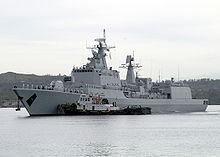
A Type 051B destroyer (NATO Luhai-class), 167 Shenzhen 深圳
Ships and submarines
Main article: List of active People's Liberation Army Navy ships
Aircraft
Main article: List of active People's Liberation Army aircraft
Main article: Naval Weaponry of the People's Liberation Army Navy
See also: Chinese aircraft carrier programme
During 2001–2006 there has been a rapid building and acquisition program.[79] There were more than a dozen new classes of ships built in these last five years,[79] totaling some 60 brand new ships (including landing ships and auxiliaries).[79] Simultaneously, dozens of other ships have been either phased out of service or refitted with new equipment. Submarines play a significant role in the development of the PLAN's future fleet. This is made evident by the construction of a new type of nuclear ballistic missile submarine, the Type 094 and the Type 093 nuclear attack submarine. This will provide the PLAN with a more modern response for the need of a seaborne nuclear deterrent. The new submarines will also be capable of performing conventional strike and other special warfare requirements.
The European Union has provided much of the propulsion technology for the PLAN's modernization.[81]
Ronald O'Rourke of the Congressional Research Service reported that the long term goals of PLAN planning include:
- Assert or defend China’s claims in maritime territorial disputes and China’s interpretation of international laws relating to freedom of navigation in exclusive economic zones (an interpretation at odds with the U.S. interpretation);
- Protect China’s sea lines of communications to the Persian Gulf, on which China relies for some of its energy imports; and
- Assert China’s status as a major world power, encourage other states in the region to align their policies with China, and displace U.S. regional military influence.[82]
A Chinese website stated that the PLAN is going to build a 110,000 ton aircraft carrier, essentially a larger version of the Liaoning.[83]
The PLA Navy plans to establish three aircraft carrier battle groups by 2020. The Liaoning and China's first domestically built carrier, currently under construction, will be part of the battle groups. One of the battle groups is to be deployed in the East China Sea, while the other two are to be deployed to the South China Sea.[84]
The PLAN may also operate from Gwadar or Seychelles for anti-piracy missions and to protect vital trade routes which may endanger China's energy security in the case of a conflict.
According to various analysts, the PLA Navy may want to establish naval bases along the "string of pearls" in the Indian Ocean that stretches across Myanmar, Bangladesh, Sri Lanka, Pakistan, Iran and possibly Yemen. This basically encircles India and will pose a major challenge to India's control over the Indian Ocean if such a plan materializes.
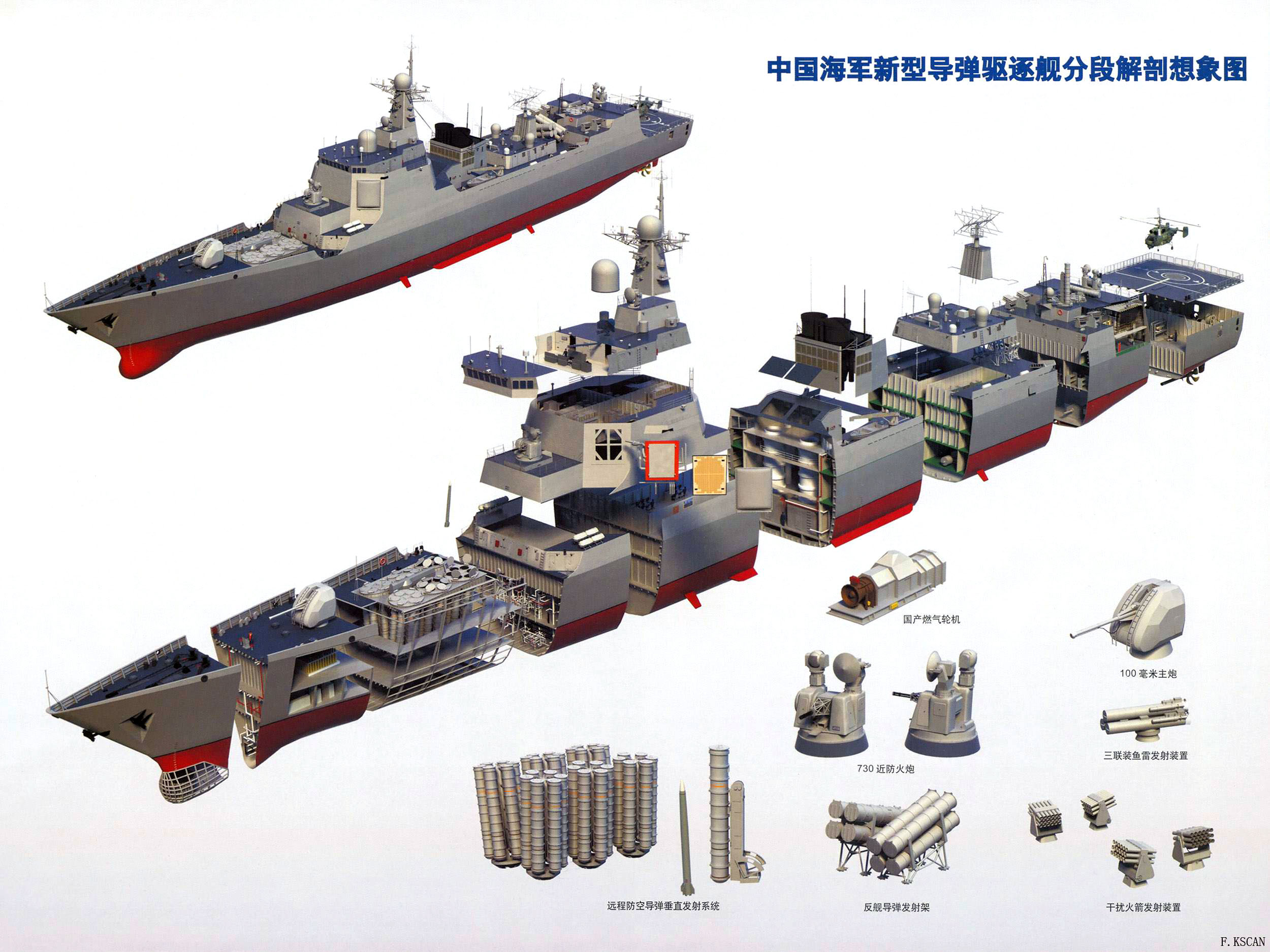








No comments:
Post a Comment